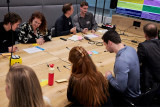How do we keep the expanding Zuidas attainable and vibrant for the people? Those were the vital questions during the InnovationLab Zuidas that was held during the Unlikely Allies opening event of the Impact Hub on Friday 31 March.
What kind of people will be living and working at business district Zuidas in a few years from now? What would they require from the area? How do we keep the expanding Zuidas attainable and vibrant for the people? Those were the vital questions during the InnovationLab Zuidas that was held during the Unlikely Allies opening event of the Impact Hub on Friday 31 March.
In 2019 the accessibility of the Zuidas will become a real challenge. In a few years, the southern section of the road A10 will be widened, a tunnel will be created and the railway station will be upgraded as one of the main stations of Amsterdam. It is clear that the ongoing construction works will cause disruption. Apart from all these challenges, Amsterdam Smart City, Impact Hub, TransportLAB and UrbanConnectors wanted to deep dive into an underexposed topic: the impact of these operations for the thousands of people working and living in and passing through the area.
Around twenty people with an interesting mix of backgrounds attended the Innovation Lab. From social changemakers to project managers in the area itself and from policy makers to mobility experts, they participated in a so-called Mobility Café. In three rounds, groups talked, wrote and drew about the ideal mobility experience for people living and working on the Zuidas in 2025, the necessities to realize this experience and the concrete social interventions for the period of 2018-2020.
For instance, when will people take the bike to work instead of the car? How can we make sure people connect with each other more? And what does a vibrant Zuidas look like? Result? The various prototypes with a strong focus on the social side of the transition of the Zuidas had a lot to do with nudging, campaigning, behavioural change and fun. According to the attendees, the follow-up of this session should be focussing on cooperation with the various partners in the area, including the local residents and entrepreneurs.
A few of the 15 prototype examples:
All employers encourage their employees to cycle to work on Fridays, even CEOs do it. On Thursdays everyone gets a reminder to go to work by bike on Fridays. Because everybody working, living an studying on the Zuidas does this, going by car is a real no-go. Friday = bike day!
People are people and we love to interact. When we are busy we just sometimes forget this. Yellow will help you remember. Carry a yellow umbrella and someone might join you in the rain! Take a yellow mug and people will drink a coffee with you. A yellow mark on someone’s car? Carpooling!
The Zuidas is a busy space in Amsterdam. Green zones will make sure everyone escapes from the rush. Just read some documents in the park or join a Friday afternoon barbecue. Can’t find the building you need to be for your appointment? Just follow a coloured line on the floor. And in summer? Sleep near your work on the pop-up campsite!
Wat would your ideas be for a vibrant and attainable Zuidas? Are there any examples Amsterdam can learn from? How can be keep on interacting during construction works and how is the area kept attainable? Leave them in comments here!





